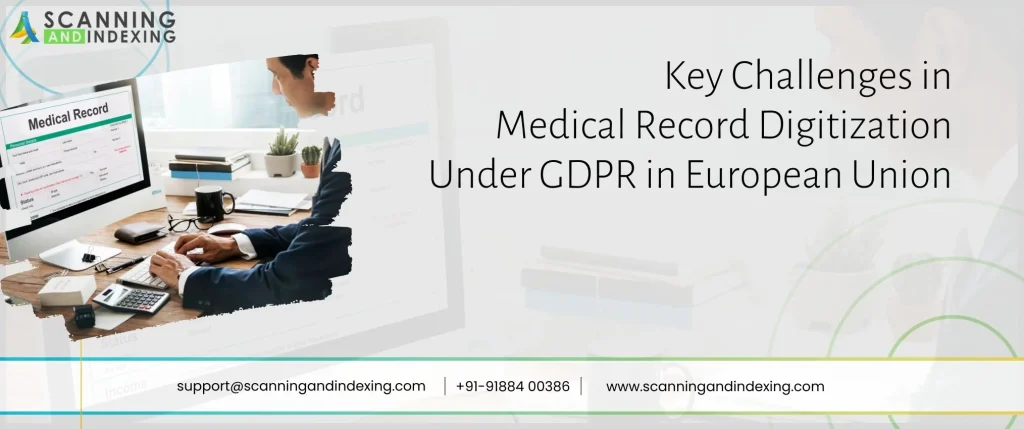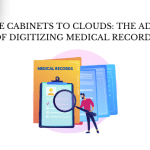Key Challenges in Medical Record Digitization Under GDPR in the European Union
Medical record digitization transforms the older records into an orderable digital format which gains accuracy and efficiency in healthcare. It simplifies patient data management, keeps it secure in the database, and makes it available with a simple touch. Medical record digitalization provides an innovative ecosystem of seamless patient care to improve operational workflows, reduce errors, and meet regulatory standards.
National Laws in Medical Confidentiality (US)
The Privacy Rule was released by the U.S. Department of Health and Human Services (“HHS”) to carry out the Health Insurance Portability and Accountability Act of 1996 (“HIPAA”). The Privacy Rule establishes one of its guidelines regarding the uses and disclosures of “protected health information” for persons by “covered entities,” or certain organizations subject to the Privacy Rule.
The Privacy Rule and any Administrative Simplification rules apply to health plans, healthcare clearinghouses, and healthcare providers. They include any provider transmitting or receiving health information electronically. They are tied to transactions for which the Secretary of HHS has established standards under HIPAA. Medical record digitalization services guarantee the correct digitization of patient data while abiding by regulatory requirements.
What Conditions Do You Need to Meet to Collect Health Data?
Special conditions need to be met to ensure compliance and protect patients’ privacy when they collect health data.
- You first need informed consent from patients so that you can legally gather their information. It must be clear and explain how they will use and share their data.
- Second, follow HIPAA (Health Insurance Portability and Accountability Act) rules in the U.S. This law lays down stringent rules as to the manner and treatment of medical records to protect patient’s information.
- Thirdly, implement robust, secure measures. Other protection includes encryption and access to protect data from unauthorized access. For successful Medical Record Digitization, create protocols for how your data will be accurate and safeguarded.
Reliable digitized records are needed to be sure that the digitally created records are complete and comply with patient care. Meeting these conditions ensures a trusted environment for both a patient and a healthcare provider.
Main Challenges When It Comes to Doing Medical Record Digitization Under GDPR in the European Union
Medical record digitization is now a key part of modern healthcare. Unfortunately, in the European Union, this poses a different challenge, with strict requirements under GDPR (General Data Protection Regulation). Here are the main hurdles organizations encounter.
Data Security and Privacy
GDPR takes data privacy very seriously, particularly when it comes to sensitive personal information. Special data, like medical records, require extra safeguards because they are identified under that category. If organizations can’t prevent data breaches, they need to implement effective security procedures to deal with the aftermath.
Management of Consent
Under Medical Record Compliance EU, GDPR, it is essential to receive patients’ consent first before you process any medical records. It is often difficult to get clear and informed consent. Patients need to know how it will be used, stored, and shared. It can be a time-consuming process.
Right of Removal and Access
Patients have a right to access that data, and if they want, to request its deletion. Medical Record Digitization service necessitates that systems have the capacity to supply these requests promptly. It might be challenging to verify if these rights are being technically maintained.
Cross-Border Data Transfers
There are many healthcare providers that work in conjunction with international partners. GDPR limits the transferring of personal data to companies outside the EU unless very strict conditions are met. It is a big challenge to deal with global stakeholders and ensure compliance.
Data Minimization Principle
GDPR requires data to be collected and used only as it is needed. What makes something ‘necessary’ when it comes to medical records can be subjective. Although this principle is easy to state, it is very important to plan carefully or at least regularly audit your health. Comprehensive GDPR training is required for staff members who handle medical records. Adhering to stringent standards is necessary for Medical Record Compliance EU, GDPR.
Conclusion
Medical record digitization in the European Union, under GDPR, is meant to support increased healthcare efficiency while protecting patient privacy. Digitizing Health Records helps to enable providers to reduce errors, improve care delivery, and allow for access to records at your fingertips.
GDPR mandates rigorous adherence to privacy, data security, and in this case patient permission. Digitization with robust encryption and governance gives us a way to better health outcomes while maintaining trust.
Handling the document management process alone is not a good decision because it involves various challenges. Thus, we are here to help you with the best medical record scanning services. You can contact us at [email protected]






